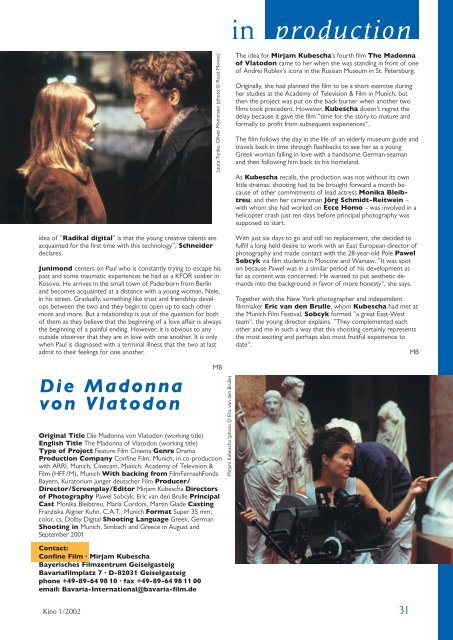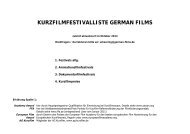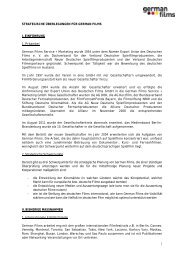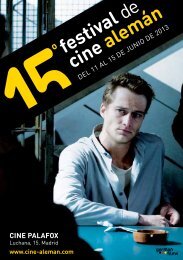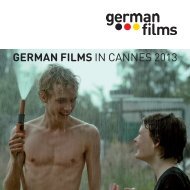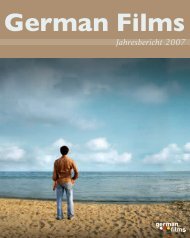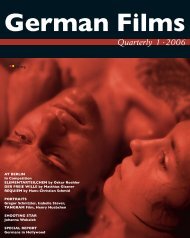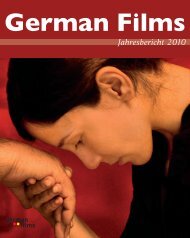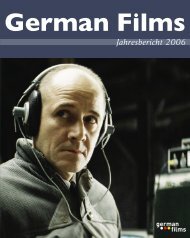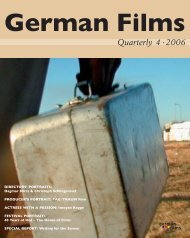Titel Kino 1/2002 - German Cinema
Titel Kino 1/2002 - German Cinema
Titel Kino 1/2002 - German Cinema
Create successful ePaper yourself
Turn your PDF publications into a flip-book with our unique Google optimized e-Paper software.
idea of ”Radikal digital” is that the young creative talents are<br />
acquainted for the first time with this technology”, Schneider<br />
declares.<br />
Junimond centers on Paul who is constantly trying to escape his<br />
past and some traumatic experiences he had as a KFOR soldier in<br />
Kosovo. He arrives in the small town of Paderborn from Berlin<br />
and becomes acquainted at a distance with a young woman, Nele,<br />
in his street. Gradually, something like trust and friendship develops<br />
between the two and they begin to open up to each other<br />
more and more. But a relationship is out of the question for both<br />
of them as they believe that the beginning of a love affair is always<br />
the beginning of a painful ending. However, it is obvious to any<br />
outside observer that they are in love with one another. It is only<br />
when Paul is diagnosed with a terminal illness that the two at last<br />
admit to their feelings for one another.<br />
Die Madonna<br />
von Vlatodon<br />
Original Title Die Madonna von Vlatodon (working title)<br />
English Title The Madonna of Vlatodon (working title)<br />
Type of Project Feature Film <strong>Cinema</strong> Genre Drama<br />
Production Company Confine Film, Munich, in co-production<br />
with ARRI, Munich, Cinecam, Munich, Academy of Television &<br />
Film (HFF/M), Munich With backing from FilmFernsehFonds<br />
Bayern, Kuratorium junger deutscher Film Producer/<br />
Director/Screenplay/Editor Mirjam Kubescha Directors<br />
of Photography Pawel Sobcyk, Eric van den Brulle Principal<br />
Cast Monika Bleibtreu, Maria Cordoni, Martin Glade Casting<br />
Franziska Aigner Kuhn, C.A.T., Munich Format Super 35 mm,<br />
color, cs, Dolby Digital Shooting Language Greek, <strong>German</strong><br />
Shooting in Munich, Simbach and Greece in August and<br />
September 2001<br />
Contact:<br />
Confine Film · Mirjam Kubescha<br />
Bayerisches Filmzentrum Geiselgasteig<br />
Bavariafilmplatz 7 · D-82031 Geiselgasteig<br />
phone +49-89-64 98 10 · fax +49-89-64 98 11 00<br />
email: Bavaria-International@bavaria-film.de<br />
<strong>Kino</strong> 1/<strong>2002</strong><br />
Laura Tonke, Oliver Mommsen (photo © Road Movies)<br />
MB<br />
Mirjam Kubescha (photo © Eric van den Brulle) in<br />
production<br />
The idea for Mirjam Kubescha’s fourth film The Madonna<br />
of Vlatodon came to her when she was standing in front of one<br />
of Andrei Rublev’s icons in the Russian Museum in St. Petersburg.<br />
Originally, she had planned the film to be a short exercise during<br />
her studies at the Academy of Television & Film in Munich, but<br />
then the project was put on the back burner when another two<br />
films took precedent. However, Kubescha doesn’t regret the<br />
delay because it gave the film ”time for the story to mature and<br />
formally to profit from subsequent experiences“.<br />
The film follows the day in the life of an elderly museum guide and<br />
travels back in time through flashbacks to see her as a young<br />
Greek woman falling in love with a handsome <strong>German</strong> seaman<br />
and then following him back to his homeland.<br />
As Kubescha recalls, the production was not without its own<br />
little dramas: shooting had to be brought forward a month because<br />
of other commitments of lead actress Monika Bleibtreu,<br />
and then her cameraman Jörg Schmidt-Reitwein –<br />
with whom she had worked on Ecce Homo – was involved in a<br />
helicopter crash just ten days before principal photography was<br />
supposed to start.<br />
With just six days to go and still no replacement, she decided to<br />
fulfill a long-held desire to work with an East European director of<br />
photography and made contact with the 28-year-old Pole Pawel<br />
Sobcyk via film students in Moscow and Warsaw. ”It was spot<br />
on because Pawel was in a similar period of his development as<br />
far as content was concerned. He wanted to put aesthetic demands<br />
into the background in favor of more honesty“, she says.<br />
Together with the New York photographer and independent<br />
filmmaker Eric van den Brulle, whom Kubescha had met at<br />
the Munich Film Festival, Sobcyk formed ”a great East-West<br />
team“, the young director explains. ”They complemented each<br />
other and me in such a way that this shooting certainly represents<br />
the most exciting and perhaps also most fruitful experience to<br />
date“.<br />
MB<br />
31


